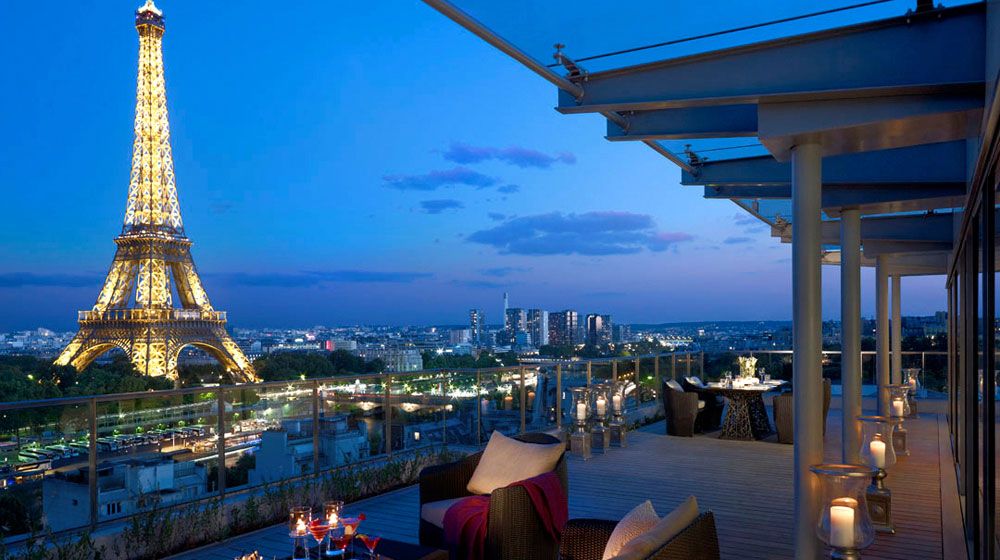Stepping into the Suite Shangri-La, my breath literally catches in my throat and behind my eyes I feel the warm, stinging sensation that precedes tears. Before us, through floor-to-ceiling windows, stretches a panoramic view of Paris at sunset; in the east, Sacré-Coeur still white against the coming dark and, over La Defense in the west, the sky glows redly like the dying embers of heaven’s fireplace. Directly ahead, so close that it seems a mere stretch over the balcony would allow one to touch it, is the Eiffel Tower: iconic, imposing, timeless.
Beauty, like love, is a word that should only be used when one really means it. Paris, from this lofty platform, is an unquestionably beautiful city. Although we are not staying in the rooftop suite, something about the angle of our room draws us immediately to the windows.The Eiffel Tower looms large over the full-width balcony and the lower half can even be seen from the shower cubicle, clearly reflected in the mist-free bathroom mirror until the frosted glass door is shut (although the presence of the luxurious rain shower and exquisite BVLGARI White Tea toiletry products are comforting in the temporary absence of la dame de fer).
The room is very spacious and comfortable; the decor is modern – a style the hotel calls ‘luxury minimalist’ – with pale furnishings and dark wood. A bottle and glasses await us, along with a fruit bowl that contains one of the juiciest pears I have ever eaten in my life. As one would expect, the room comes complete with all the necessary technological devices, including coffee machine, flat-screen television and stereo with iPod dock. Most commendably, considering the minimal cost to the hotel in comparison to the room rates and the current trend of luxury hotels making astronomical additional charges, Wi-Fi and broadband are complementary.
We were shown around by executive assistant manager Frederic, who is cheeky, funny and very knowledgeable about the hotel, although he admits that concierge Tony – who studied to become a history teacher before he ran away to join the hospitality industry – can give a more detailed account of the building’s past. The Shangri-La Paris hotel was originally built in 1882 as the home of Prince Roland Bonaparte, grandson of Lucien (brother of Napoleon I). His initials – which, conveniently for my taking up permanent residence, are the same as mine – are woven into the carved doorframes and ornate ceilings, along with the Napoleonic symbol of the bee.The original architect, Ernest Janty, used a variety of styles from the 17th and 19th century and the eclectic design works together, from the solid marble pillars on the sweeping staircase to the majestic Grand Salon, the masculine Salle à Manger with huge, imperial, wooden eaglesand the pastel Salon de Famille. The overall effect is impressive, stately, completely Parisian. The restoration that took place after the building was acquired by the Shangri-La group in 2006 was masterminded by architect Richard Martinet and Pierre-Yves Rochon, an award winning interior designer who specialises in luxury hospitality environments. The lobby is lightly scented with Shangri-La’s signature fragrance and artwork throughout the hotel is full of references to the group’s Asian origins. The hotel is still undergoing some changes – Frederic tells us that the neighbouring building will also soon become part of the hotel, adding another 20 rooms.
We are also fortunate enough to be some of the first people to get a glimpse of their new spa, which houses two luxury treatment rooms, a fitness centre and a neo-classical pool, complete with columns and flooded with natural light. The historical symbolism has been preserved and the imperial L’Abeille (‘the bee’) is also the name of the hotel’s two Michelin starred, French fine dining restaurant, one of three restaurants in the hotel. La Bauhinia serves food all day under the stunning, original, glass cupola at the rear of the main lobby. The final restaurant – where we are to dine – is the Shang Palace, which serves Cantonese food to a standard worthy of its Michelin star, possibly the only star in Paris awarded to a fairly traditional – if luxury – Chinese restaurant.All these restaurants come under the guidance of Executive Chef Phillipe Labbé and, since they each have their own character, we are lucky to be able to eat in La Bauhinia for breakfast and sample another angle of the hotel’s approach to cuisine. The jade and burgundy dining room, with lots of dark wood, is a brave design direction but somehow it works and conveys a sense of relaxed calm, perfect with scrambled eggs, hot coffee and crêpes. The Shangri-La Paris is a delightful hotel at which to be a guest, due to the willingness of the staff to intuit and meet every possible request and, of course, the magnificent building where artists and socialites of the French elite came to socialise in years gone by. Academia was also represented; Roland Bonaparte invited guests that he knew through his presidency of La Société de Géographie and L’Académie des sciences, and he was father to Marie, a prominent Freudian who is credited with bringing psychoanalysis to France.
With this all in mind, the beauty – yes, I’ll say it again – of the last daylight from the Suite Shangri-La makes me think of Freud, in whose work I recently came across the theory that knowing the transience of things causes a kind of pre-emptive mourning. Standing on the terrace in the fading daylight of our second night’s stay, I do feel the sadness of our impending departure, but the impeccable service and accommodation are a fine consolation and, of course, I can return. The Eiffel Tower shimmers in the darkness. There will be another sunset.
Shangri-La Hotel Paris
10 Avenue d’Iéna
75116 Paris
France


